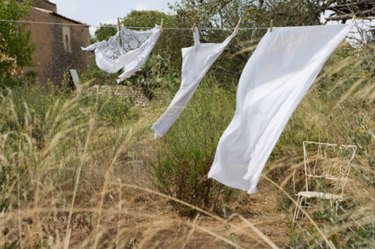
Technically, there is little dissimilarity between different types of textiles. The distinctions are often found in the usage and the weaving technique used to make specific types of fabrics. Some textiles such as velour and terry cloth have enough differences in their fabrication and usage to be distinguishable from one another to the naked eye.
Velour
Video of the Day
Velour is actually the French name for velvet, aptly so since it was first created in Lyon, France, in 1844. It is a thick, plush and soft fabric with a plain or satin ground that can give it a pebbled effect. Varieties of velour include cotton velour, ribbed velour, wool velour or polyester velour. It can be made from natural fibers such as cotton and wool, or synthetic fibers including nylon and spandex. Velour is used to make hats, dressing gowns, dresses, waistcoats and upholstery.
Video of the Day
Terry Cloth
Developed around 1850 in England, terry cloth, also known as terry toweling, is a fabric made of tiny loops that can absorb large amounts of water. Generally, terry cloth is made from cotton but variations can also be made of other materials such as bamboo and microfiber. Terry toweling is a very strong fabric that can resist rubbing, pulling, twisting and tugging and gets even stronger when wet. This type of fabric is most often used to make towels, bath robes and beach cover-ups, infant and children's wear, slip covers, draperies, exercise wear, other apparel and even toys.
Similarities
Both types of fabric are most commonly made with cotton, although velour and terry can also be made from other natural and synthetic fibers. Softness and durability are other common points of both of these types of fabrics, although other properties such as absorbency and flexibility differ.
Differences
The first difference between velour and terry is the way they are produced. While velour is created using either a plain weave or a satin weave construction, terry cloth is constructed by using two sets of wrap yarn to create uncut loops on the pile. This is why velour has a rough look while terry can be identified through its many tiny loops.
Another major difference lies in their most common usage. Because of the lushness of velour, it is most often used for clothing items and upholstery, while the water-absorbent qualities of terry make it much more useful for items such as towels, sporting clothes and infant nappies and toys.
Finally, while velour is a flexible and stretchy fabric, terry cloth tends to be inflexible in comparison. When wet, velour will simply become dense and heavy, while terry cloth will absorb liquids and become even more resistant to wear and tug.